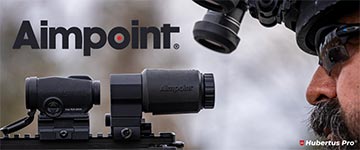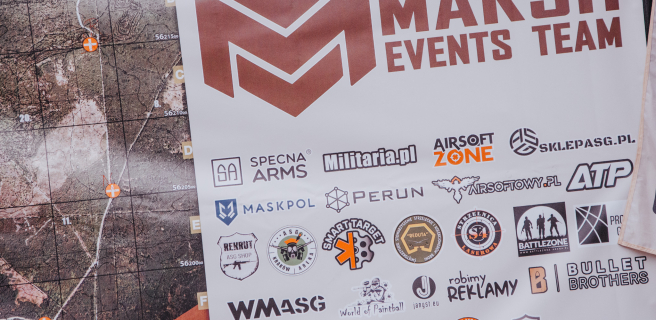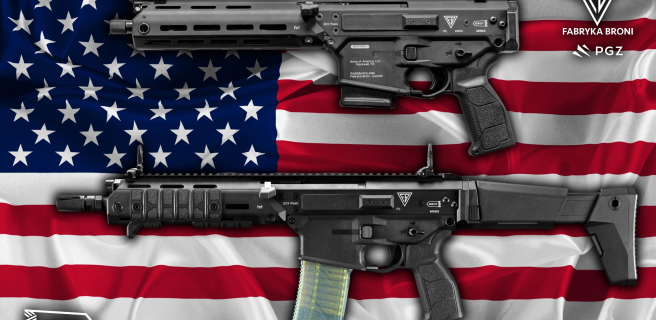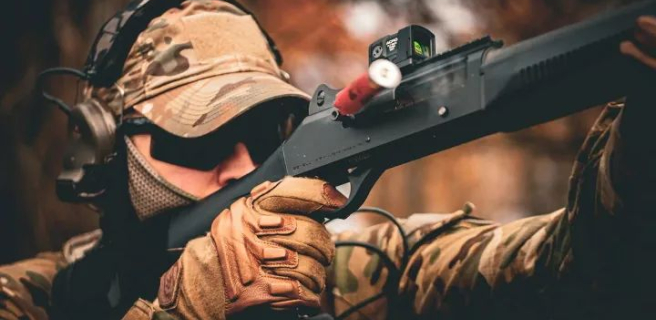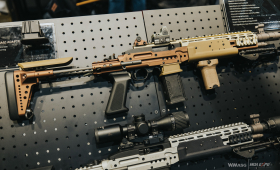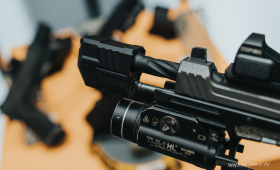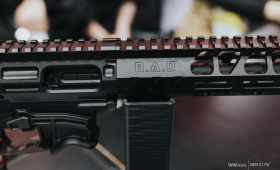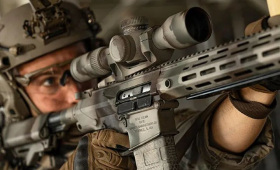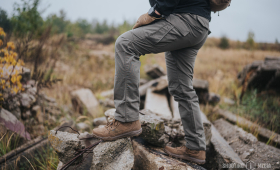Everyone eventually gets bored with weekend skirmishes. Generally you got a choice - either you enrich your hobby or you get dropped out. It is easier to find a living dragon than someone, who choose option number three.
Mil-sims, patrols in the field and similar pleasures - that is what you want. There are people who are in it for a longer time than me and I am sure they got a lot more experience than me. But still, I know a thing, as I sweated and bleeded out some litres, not to mention all downpours are freezes I went through.
Photo 1: Smock type jacket. Everyone, who spent some more time in a forest than just a a duration of usual skirmish will appreciate following features - capacious pockets, loose design and a hood. Properly impregnated will do the job in a wide spectre of weather conditions, but in real nasty winters membranous jacket will perform a way better.
Painful beginning
It will hurt, as my advice for a begining goes like that - pack your rucksack with everything you find suitable for 24 hours run in a field. wear your complete gear and go for 20-30 kilometer march in some kind of Podunk. When you are back, you will perfectly know which part of your equipment kicks your butt hardest. Exchange it or adjust it and after some time repeat the whole process. And again. And again. Until you are fine. One standing motionless, actually gets backwards. After few trips in a field you will learn faster and recognize your strong and weak spots. And - what is the most probable - you gonna get rid of a ton of supernumerary gizmos.
After some weeks or months you know exactly what hurts and why. You also know what in your gear works just fine, what sucks and what is totally redundant. So, now you are facing a new dilemma - what I should exchange it for?
The more "cheap, good substitutes" you got, the more your opponets are happy. Your effectiveness is a sum of vectors and you simply desire them to head the same direction. Miserable and faulty gear causes you wasting more energy for fight against something what should theoretically be your ally in the mission. It weakens your morale, causes frustration, deconcentration and increases fatigue. All of these factors got cumulated and you keep on making mistakes.
As you can see below, I tried to describe in "user-friendly" way, what one should wear in a field to feel good. I will prepare some more texts about stuff you should keep in your clothes and webbing. If some of you find following advices trivial - I am deeply sorry. I have done my best in presenting the topic in the most complex way possible, what includes some basics as well.
Clothes - from toes up
Boots. Whenever I see a person trying to save some pathetic change here, I am getting absolutely freaking mad. First of all - you need at least two pairs. Former to be worn in warm season (spring and summer), latter make cold season (fall and winter) bearable. First one is light and quick-drying, second one somehow waterproof and keeping your feet warm. One pair is perfectly enough only when you can afford spare pair of feet. I know, that budget is crucial here, but blind following your wallet is a terrible, terrible mistake.
First of all - your boots must be comfortable, worn in and keeping your ankle snugly. I know - it is obvious, but plenty of folks seems to keep on forgetting it. Bovver boots are not good boots. Used boots from army surplus are perfect for garden works only. China-made boots are a price lottery. I will not get into details, as it is one of these bottomless topics. Nevertherless, I use US Jungle Boots and BW 2005 boots. They are compliant with my needs for now. Although I start to look for something better, especially for summer. Obviously, you need to take care of your boots - in case of leather you must polish it from time to time. When your boots are made of nubuck - they must be impregnated with appropriate moisturizing formulas.
Photo 2: Yearlong boots (left) and summer ones (right). As using former ones during a summer is possible, wearing latter ones during a winter is like making a first step straight into a beautiful catastrophy.
Good insoles and trekking socks. Purchase it and you will appreciate a difference between them and budget substitutes. First of all, they limit scrapes and blisters. Some of you may still require additional assistance of counters and heel cushions. If your foot is already hurt, you would like to have some Compeed brand plasters with yourself. They saved my skin for several times already. Sure, I know people made it throuh centuries without such gadgets, but being a martyr is poibtless. You are not going to get any closer to salvation through it and when you damage your feet for good you become nothing but a burden for your team. Not to metnion the fact, wearing incomfortable shoes will be back with severe pain in some years.
Knee pads. After your feet is secured - it is high time for your knees. All knee injuries are severe, painful, difficult and time-consuming. Especially when you cannot afford a private clinic. I am obsessed about it and I advice you - be like me. Whem you get your ligament torn, meniscus broken or joint capsule sangged, you are out for a year. Plus you will need to get it fixed by surgery, as ignoring this problem will cause in collateral joint damages. For instance, keeping your ACL (anterior cruciate ligament) torn is an invitation for knee arthroplasty in 15-20 years. After it you will visit forest only during mushroom season.
That's why you must invest your money in good knee pads. I got my Altas for years and this purchase got back to me thousandfold for now. Well, I am rather clumsy. I know, you can get combat pants with special pockets for soft inner pads, but I prefer to sacrifice some of my comfort to ensure full protection. Additionaly you should train muscles stabilizing your knees to minimalize a chance for your joint being twisted. It is rather easy to get such accident in the forest by night.
Photo 3: Good knee pads are nothing but a blessing. Alta Industries knee pads visible above ensure brilliant knee protection and are very easy to be fixed in a field. If you claim, knee pads are totally expendable toy for whiners, just check the shell damages above and imagine all damages that would be taken by a joint.
Gloves. Vital during a whole year - obviously not just one, but at least two pairs. They keep small but annoying hand injuries like burns and cuts away. They are a part of camouflage too. They do not need to provide a perfect touch. Airsoft is not a sport shooting. We got different priorities here. Hand protection in the first place. Precision is somewhere behind it. For making notes or using map and compass, glove can be taken off. You can also cut two fingers down. I am in opinion spending sick amounts of money on it is pointless. Gloves are easy to be left behind by accident and losing one equal losing a pair... I use current BW model - it is in flecktarn, but I do not care. My gloves are comfortable, cheap and flame resistant.

Eyeshield. Must be comfortable and fogging-proof. That's why goggles are not a good choice. You would feel like bitting your own face off after spending 24 hours in a row in one of these. Glasses providing good cover of eyes and their surroundings are must for me. Spectacles are useful even during trips with no shooting. I bet you do not want to have your eye poked by some random branch while roaming in a forest by night. I witnessed almost poking once, so I am not making this one up.
Photo 5: Ballistic spectacles are not a must, but it is great to be sure your eyeshield is designed to hold a lot more dangerous projectiles than just a plastic pellet shot from a toy-gun.
Underwear. I would not be so restrictive about wearing thermoactive closthes, as cotton is quite fine that time (although cool max t-shirt perfroms a lot better). Well, it absorbs crazy amount of water, but it is bearable, as it eventually dries out rather fastly. And you should know how to deal with "sheriff syndrome". But during a winter, good thermoactive clothes are must. First of all they increase your comfort, facilitate keeping appropriate body temperature and provide a significant advantage over wet and freezing opponents, which does not utilize it. Besides, who feels like suffering some rheumatism in a future, right?

Headwear. Adjusted for weather conditions. Hat, patrol cap, baseball cap... It is your call. Beret sucks. It is worth to have a warm watch cap in your pocket all year long, as apart from very hot days, temperature loves to drop significantly before dawn even in such warm months like May or August.
Photo 7: Material caps adjusted for weather conditions will perform a lot better in a field than helmets, as long as during mil-sims ballistic protection is not rewarded. Then it is reasonable to consider a purchase of real one or replica.
Neck camouflage. It is not absolutely necessary piece of equipment, but rather useful, considering camouflage cream getting wiped from a neck quickly. It may be a good solution for keeping your throat warm or as additonal camouflage in an ambush (in case of so called sniper scarf).

Gaitors. They are essential during cold months, when humid pants can get your body cold in just a couple of hours. This invention will e appreciated by anyone, who experienced wet pants getting iced.
Photo 9: Another invention for "whiners" - gaitors. Thanks to them you can easly move through mud and snow reaching 3/4 of your calf. Everyone who felt freezing pants would want to have it.
Belt. Recently Cobra buckle belts are on a top. Such belt can be used as improvized as a harness. If you do not intend to play with ropes, you will be satisfied with usual belt in restrained colors. Tactical belt is a poor belt for you pants. It is the best way to have your hips painfully coarsed.
Uniform. The most important material was quick-drying, not too thick and camouflage was appropriate for surroundings. It is easier to wear numerous layers to obtain desired thermal comfort than to wear one thick piece of clothes. That is why it is better to wear "summer" versions of uniforms all year long. For a longer time I utilize British DPM from Soldier 95/2000/2005 series. It is my personal winner in price/quality category, but I am afraid I will need to find a new pattern soon. The other imprtant factor is a design - the number of pockets must be sufficient for all vital equipment what is good to have with yourselves. I will present it in the next part of this series.
The selection of uniform parts according to the weather demands some experience. There is just one way to get it - going out in a field to recognize your own needs. Parts of your uniforms should have a possibility of connecting in various ways to get an optimal effect. I own pants, shirt, smock, MVP jacket, thick and thin fleece. Completed with appropriate thermoactive or usual underwear it lets allows me to regulate my thermal comfort to the majority of weather conditions I can ancounter in Poland. I would need to buy white winter camuflage over-all, but recent mild winter discourage me from making this purchase.

Photo 10: As "multicamouflages" are rather poor in typical spring-fall period summer, they perfectly blend in during snowless winter. British MTP above
Summary
The selection of clothes and protective equipment is a bottomless subject. It is actually a compromise between safety, comfort and a budget of a buyer. In this part of the guide I tried to present all involved pieces in possibly complete and reader-friendly way. Of course numerous theads have not been explained in satisfying way and I am aware of this fact, but these are very broad topics deserving for separated texts. I have not wanted to go to deep in some questions, as it would caused severe disproportion between certain points. Soon another part of this quide will be published. It will contain all items you should posses with yourselves to survive mil-sim in a way of being prepared for almost everything what can a counter you in a forest.
Traditionally, I encourage you to share your remarks and ask questions in comments below. I would like to know if you agree with my list or maybe you would add something more to it?


